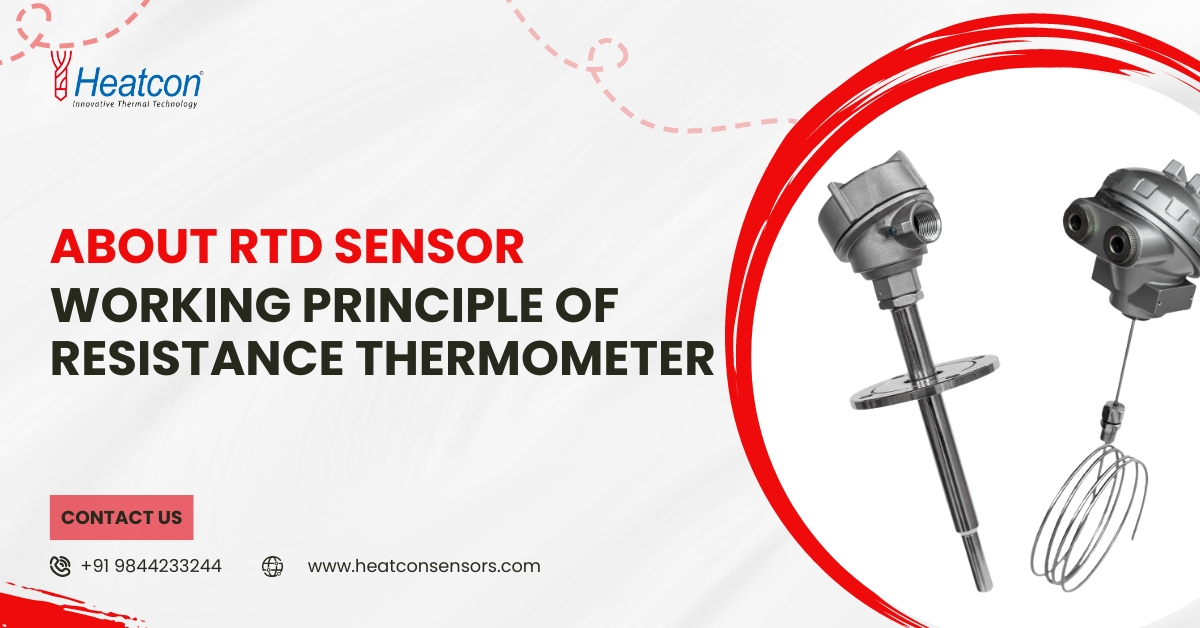An Overview on RTD Temperature Sensors
The full form of RTD sensor is “Resistance-Temperature-Detector.” It happens to be a type of temperature sensor RTD, which is utilised widely for measuring temperatures by correlating the resistance of the RTD’s element with the variations happening in temperatures during certain types of industrial processes. The RTD temperature sensor tends to rely on a basic principle where the resistance grows linearly with a rise in the temperature. RTDs sensor typically consist of fine platinum wire, which is either wound around a ceramic or a glass core or deposited as a thin film on a ceramic substrate. Such sensors tend to be housed in protective probes, which is needed for increased durability in various types of industry related applications. Thin-film RTDs tend to be far more cost-effective. This makes them a preferred choice for many industrial applications, whereas wire-wound RTDs tend to provide a higher degree of precision, specifically for high-temperature readings. Both of these types tend to serve the same purpose but they differ in their terms of performance as well as cost. Let us discuss the working principle of the resistance thermometer.
Working Principle of Resistance Thermometer (RTD)
So, what is RTD & how does it work? The working principle of resistance thermometer tends to revolve around the relationship between electrical resistance & temperature. As the temperature of the sensing element mounts, so does its electrical resistance. An electrical current passes through the RTD sensor, and the resistance value is then measured. Such resistance is then changed into temperature using the element’s resistance-temperature characteristic. An RTD diagram will typically depict this resistance element, which is usually made of platinum, and which is connected to insulated wires. In some cases, RTDs use three or four wires for eliminating any errors that may be caused by the lead wire resistance. The result happens to be an accurate & stable RTD temperature reading.
Types of RTD Sensors
- Wire-wound RTDs: Such sensors tend to consist of ultra-thin platinum wire coiled & housed in a glass or ceramic tube. These tend to provide high accuracy. They are suited for high-temperature situations.
- Thin-film RTDs: Such sensors are made by depositing a thin layer of platinum onto a ceramic base. While these are less accurate than their wire-wound versions, these thin-film RTD sensors tend to be far more cost-efficient & robust, which makes them suitable for applications involving vibrations.
What Are RTD Sensors Used For?
Such sensors are favoured for their high precision as well as stability over time, specifically in environments that need accurate temperature control as well as monitoring. The application of resistance temperature detector spans a multitude of industries, as follows:
- Automotive: These sensors are utilised in the automotive industry for monitoring engine & exhaust temperatures. This is needed for optimum performance & better emission control.
- Aerospace: In the aerospace sector, these sensors tend to ensure accurate temperature measurements in critical systems like aircraft engines & environmental control.
- Medical electronics: These sensors are utilised widely in the medical electronics segment where they help in regulating temperatures in sensitive medical equipment like incubators & diagnostic devices.
- Power electronics: These are also utilized in the power electronics industry for maintaining temperature control in systems like transformers & inverters, which helps in preventing overheating.
- Consumer goods: RTDs tend to be integrated into appliances such as ovens & refrigerators for maintaining uniform temperatures for effective operations.
- Industrial manufacturing: In the industrial manufacturing sector, these RTD sensors help in monitoring temperature in processes such as chemical production, for ensuring precision & safety in operations.
Testing an RTD Sensor Temperature
To test an RTD sensor temperature, a multimeter set to resistance mode can be used. At room temperature (~20°C), the resistance should read around 110 ohms. For a more thorough test, you need to place the RTD temperature sensor in ice water; and this time, the reading should drop to approximately 100 ohms. This simple procedure tends to ensure that the RTD sensor is working properly by verifying its resistance at specific temperatures.
Difference Between RTD Sensors & Thermocouples
Both RTD temperature sensors & thermocouples are favoured devices, widely utilised for measuring temperatures, but they differ significantly, as follows:
- Temperature range: Thermocouples operate across a wider temperature range (-200 degrees Celsius to 2000 degrees Celsius) compared to RTDs sensor (-200 degrees Celsius to 600 degrees Celsius).
- Accuracy: RTD sensors tend to provide greater precision & stability within their range, which makes them ideal for accuracy demanding applications.
- Response time: Thermocouples usually have quicker response times; however, they provide lesser stability in comparison to RTD sensors.
RTD Sensor Tolerances & Accuracy
The DIN standard is often used to specify the resistance vs. temperature characteristics of platinum-based RTD sensors. For instance, the RTD sensor with 100-ohm platinum usually has a temperature coefficient of .00385 Ohm/Ohm/°C. Accuracy classes such as DIN Class A, B, & C tend to define the acceptable tolerance levels for RTD sensors.
Why RTD Sensors Use Platinum
Platinum happens to be the widely chosen material for RTD temperature sensors owing to its stability, repeatable results, & wide temperature range. It provides accurate temperature readings with minimum fluctuations. This ensures the RTD sensor temperature is quite reliable over time. This material’s resistance to corrosion also makes it ideal for several types of harsh process environments.
Common Applications of RTDs
High accuracy & stability make RTD temperature sensors kind of indispensable in many critical operations where accurate temperature measurements hold grave importance. The application of resistance temperature detector technology is broad, spanning a gamut of fields, as under:
- Industrial process control: These temperature sensors are widely utilised in industrial process control for ensuring precise temperature monitoring in manufacturing as well as chemical processes for quality & safety.
- HVAC systems: In HVAC systems, these RTD sensors tend to maintain accurate temperature control for efficient heating, air conditioning, & ventilation operations.
- Medical instruments: RTDs tend to be quite necessary in certain medical instruments for precise temperature regulation in equipment like incubators as well as sterilizers.
- Military and aerospace systems: These sensors are highly crucial in military as well as aerospace systems for monitoring temperatures in high-performance equipment to ensure dependability & safety under extreme process conditions.
Understanding the Benefits
The full form of RTD sensor emphasizes its role as a Resistance Temperature Detector. These sensors tend to proffer a multitude of benefits, including the ones given below:
- Accuracy: These sensors are ideal for those applications that need precise temperature control.
- Stability: Long-term stability makes RTD sensors ideal for processes where consistent performance is highly important.
- Versatility: RTDs sensor could be utilised across a host of industrial segments, like automotive, aerospace, etc., owing to their compatibility with different instrumentation.
How Does an RTD Work?
What is RTD? Such a question often leads to a more detailed look at the working principle of resistance thermometer. In essence, an RTD works on the premise that the resistance of its element tends to change in proportion to temperature. The RTD diagram gives a visualization about this process, showing the sensor’s internal structure & how it measures temperature.
Final Thoughts
Understanding what is resistance temperature detector is allows for more informed decisions in selecting the right sensor for your specific industrial application. Whether it is the accurate, stable measurements or the vast array of applications, RTD sensors tend to provide a number of advantages for industries relying on accurate temperature control. By fully fathoming the working principle of resistance thermometer, and how RTD temperature sensors operate, engineers & technicians can select the right sensor for their unique industrial needs, ensuring reliable performance & accurate measurements across a gamut of industries.


